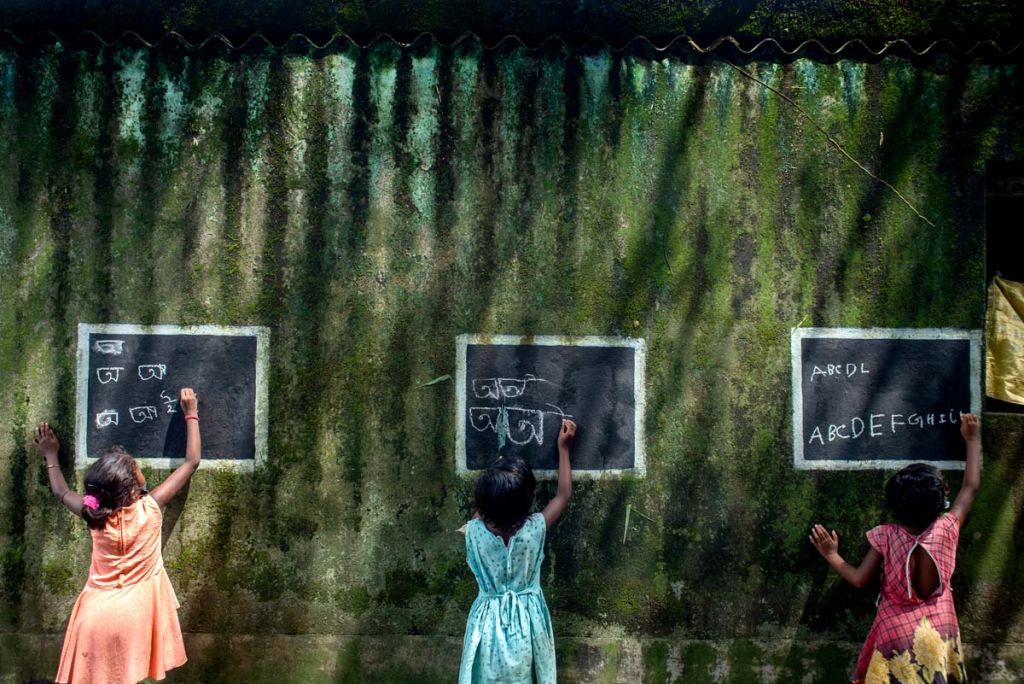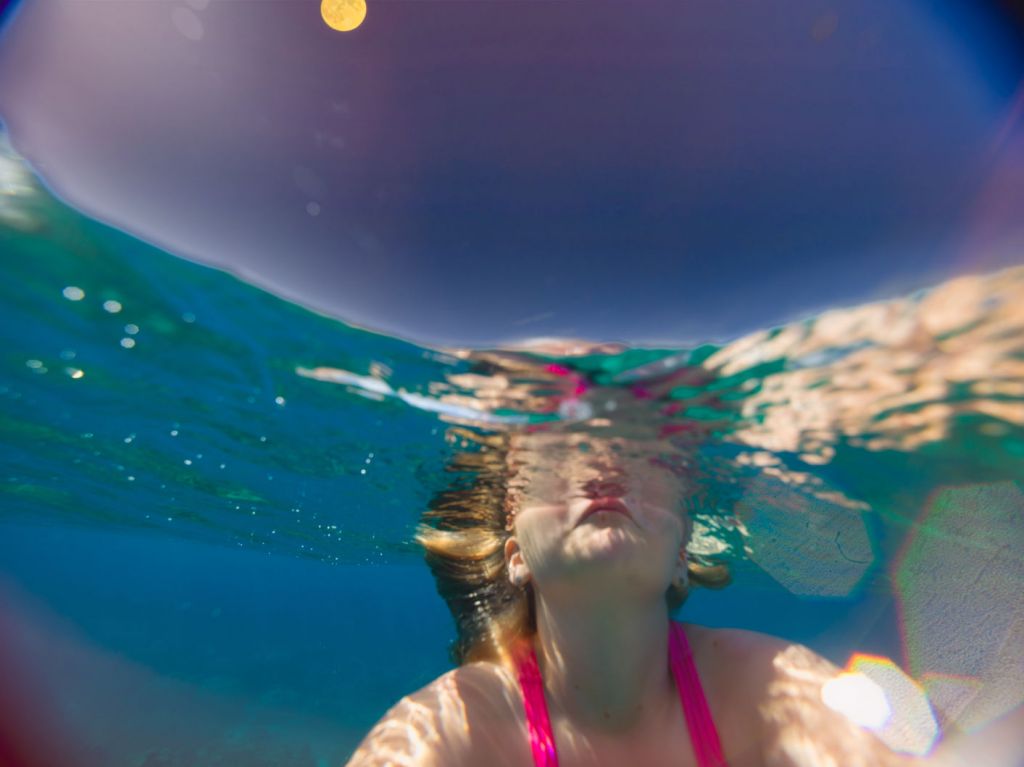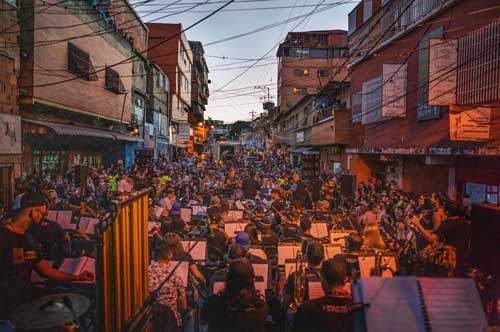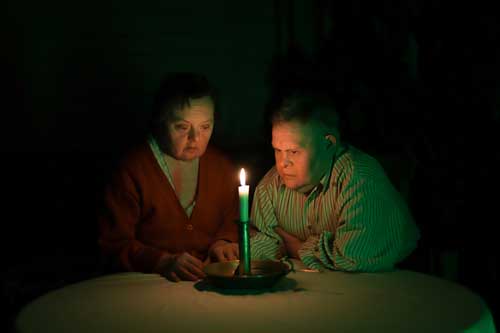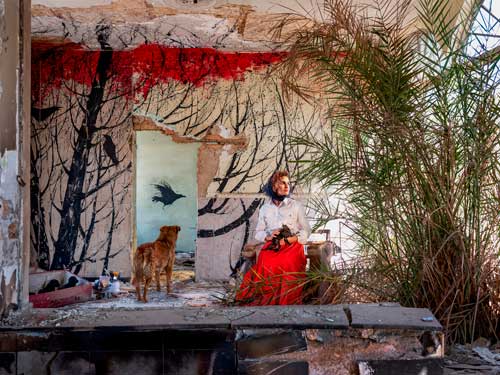The Indian photographer wins with an image from his reportage „A Small yet Great Victory Over the Pandemic“, which tells how during the global Corona-related education emergency, the initiative of Indian teacher Deepnarayan Nayak turned the walls of his village’s houses into school blackboards.
The evening’s keynote address was given by Alexander Cherkasov, representing the Memorial Human Rights Centre, which will receive the Nobel Peace Prize in Oslo on 10 December 2022.
Vienna, 14 November 2022 – this evening, the winners of the international Global Peace Photo Award competition were awarded the Alfred Fried Peace Medal at the Austrian Parliament for the tenth time.
Winners of the Global Peace Photo Award 2022
Ana Maria Arévalo Gosen, Venezuela for „Sinfonía desordenada“
Artem Humilevski, Ukraine for „Giant“
Mary Gelman, Russia for: „M+T“
Maryam Firuzi, Iran for „The Scattered Memories of Distorted Future“
Sourav Das, India for „A Small yet Great Victory Over the Pandemic“
In his welcoming speech, Wolfgang Sobotka, President of the Austrian National Council, emphasised the extraordinary cooperation with the Global Peace Photo Award and how important it is to provide a forum for peace in these times. In the future, this commitment will be even more noticeable in the Austrian Parliament. The pictures of the award winners will be shown in the auditorium for one year at a time. This is the room where mainly the press conferences will take place.
The Peace Image of the Year 2022
The main prize of 10,000 euros went to the Indian photographer Sourav Das with an image from his reportage „A Small yet Great Victory Over the Pandemic“, which reports on how, during the worldwide Corona-related education emergency, the initiative of the Indian teacher Deepnarayan Nayak turned the walls of the houses in his village into school blackboards.
For millions of girls and boys covid meant no schooling of any kind for months. And for countless other children this is still, or again, true. Already it has become sadly clear: covid has created an educational emergency across the world, which goes beyond the loss of learning the times table. In many poorer countries closing the schools also means that children forego their only certain meal of the day. But there were and still are wonderful exceptions! These are initiatives like that of Indian teacher Deepnarayan Nayak, who just moved the school in his village outdoors. He turned the walls of the houses into boards. He painted the precautions against infection on the walls, he teaches the children how to use masks and makes them attend school outdoors in safe distance to each other, even the subject of biology, including the look through a microscope. Indian photographer Sourav Das has captured everyday scenes of this unusually creative and loveable village school. He has created a small monument to this peaceful action. It realizes, on the lowest conceivable level, one of the 54 articles of the UN Convention on the Rights of the Child: the right of access to education.
Sourav Das, born in 1987, calls his camera an instrument of learning. He refers to famous Henri Cartier-Bresson when he says: With one eye you look at the world, with the other into yourself. In 2011 Das obtained a Master of Arts, then focused on photography. He sees himself as a street photographer, he wants to document social change in his society. He trusts photography to be as expressive as a novella, a song or a painting.
The best peace image in the children’s and youth category, Children’s Peace Image of the Year 2022, worth 1000 euros, was won by 10 year old Zoya Yeadon from Mauritius.
„Floating, not drowning. Surrounded by dancing light and a deep blue. Dreaming in a peaceful sea. Zoya Yeadon is a strong swimmer. But that is the most unspectacular thing you can say about her. Born in Mauritius, she really is, as her father (also in the picture) says, “a nomad at heart”. Curious about the world. She has spent the last five years in a mobile home in which she has travelled through more than 80 countries. She is being taught within a program of Wolsey Hall Oxford, a home-schooling college, maybe the most famous, certainly one of the oldest schools of its type, founded in 1894. Her best subjects? Geography, of course. And maths and English. Apart from her mother tongue, Zoya also has a good command of Russian and French. Her father describes her as “surprisingly resilient” and “steadfast in a crisis”. Cheerful and fearless – for instance, when she talks about her travels in front of 120 children and adults. Zoya uses a Leica of her father’s to take photographs. And if it existed, we would have to present Zoya with an additional award. She certainly has travelled furthest of all the award winners to be here on this beautiful evening. Landing in Dubai, she started out for Vienna on 10 October. In her father’s car, via Saudi-Arabia, Jordan, Israel, then on the ferry to Greece…“, says laudator Peter-Matthias Gaede.
The award was presented by Elisabeth Stadler, General Manager and Chairwoman of the Managing Board of Vienna Insurance Group (VIG): „Vienna Insurance Group has been a supporter of the Global Peace Photo Award since the very beginning and has previously supported the Children’s Peace Photo Award. Now we are expanding our successful cooperation and have signed a three-year cooperation agreement as the main sponsor. As a company, we – like people – need a peaceful environment to be able to do business sustainably and successfully.“
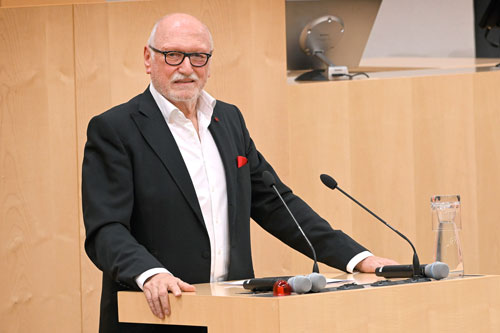
Lois Lammerhuber, who initiated the Global Peace Photo Award together with his wife Silvia Lammerhuber and has organised it since the beginning, reminded us that „peace is not the absence of war, but something I would like to call ’successful living‘. Every year the photos and stories submitted touch us anew with their creativity and passion for what is good and peaceful in this world.“
Invited by Barbara Trionfi, outgoing Director of the International Press Institute (IPI), Joanna Krawcyk, President of the Gazeta Wyborcza Foundation, Chairwoman of the Leading European Newspaper Alliance and „Golden Pen of Press Freedom“ awardee, made a plea for the value of photography in the perception of the world: „What we are clearly witnessing now is an intensification of visual culture, photography has become extremely important as a vehicle of change and a means of protest. Describing the world with images in a pluralistic media environment can only work in societies guided by freedom of information and expression. That is a core element of any functioning democracy – freedom of the media, and I see it as essential to the protection of human rights.“
Ten years of Global Peace Photo Award
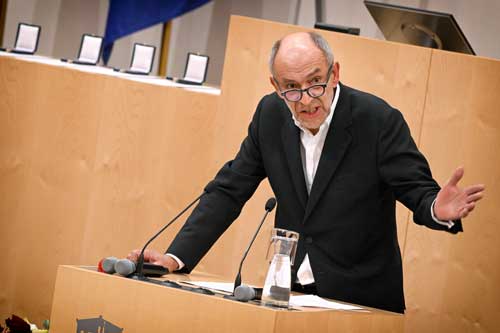
Peter-Matthias Gaede, Editor-in-Chief of GEO magazine 1994 – 2014, paid tribute to the 10th anniversary of the Global Peace Photo Award: „In the ten years of its existence, the Global Peace Photography Award has grown in size in almost every field.
The jury has become a large orchestra. 29 women and men from nine nations now belong to it – from six European countries, but also from Latin America, China and the USA. The submissions of about 15,000 pictures a year come from around 120 countries. The winners come from Iran and the USA, Belgium, Sweden and Germany, China and Indonesia, Nigeria, Ghana, Turkey, Tunisia, Argentina, Peru and Venezuela. From Greece, Italy, France, the Netherlands and Denmark. From Ukraine. And Russia.
Only apparently lured by a compelling idea, the annual awards have become a summit of globally recognised advocates of peace and human rights. I recall the speech by Kailash Satyarthi, child rights activist and Nobel Peace Prize winner of 2014, or Tunisian Abdessattar Ben Moussa, human rights activist and Nobel Peace Prize winner of 2015, who gave us the honour of delivering the keynote address at the ceremony. I recall David Beasley, Executive Director of the United Nations World Food Programme, winner of the Nobel Peace Prize in 2020, who came all the way from the United States to give a resounding hello-wake-up call to the world. And we are very pleased that with Alexander Cherkasov, member of the board of Memorial, we once again have with us today the representative of an institution that has just been awarded the Nobel Peace Prize 2022.
But I would also like to remind you of the courageous advocates of press freedom who have spoken to us here – in the person of Matthew Caruana Galizia, the son of the Maltese journalist Daphne Caruana Galizia, who was murdered in 2017. I recall the memento mori that we owe to the cooperation of the IPI, arguably the world’s most important institution for the defence of press freedom. To my knowledge, there is no other photography prize in the world that is able to animate such a high-profile and credible human rights community of people from all nations to pay tribute to photographers who were often even previously widely unknown.“
Nobel Peace Prize Laureates
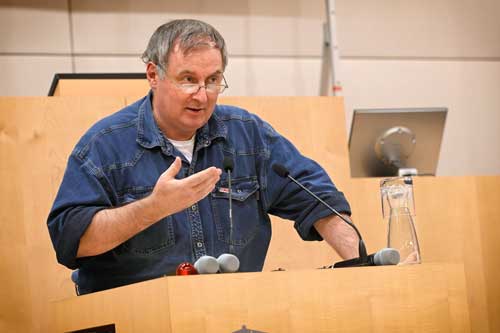
The evening’s keynote address was given by Alexander Cherkasov, representing the Memorial Human Rights Centre, which will receive the 2022 Nobel Peace Prize in Oslo on 10 December, together with the Center of Civil Liberties from Ukraine – whose chairperson Oleksandra Matviichuk had sent a video message – and Belarusian dissident and human rights activist Ales Bjalyazki.
„Indeed, Memorial has spent many years trying to do something similar to the laureates at today’s ceremony: to record the past, the totalitarian past of Russia and Europe in the twentieth century, the century of totalitarian empires, to prevent it from happening again. Never again. What kind of memory is needed for this? What was worth preserving to prevent a repeat? The memory of the victims, of course. And another memory – the experience of living in dignity under unimaginable circumstances. The memory of resistance. And also: to remember, of course, is to fight. Fighting against the impunity of criminals. (…) So the Human Rights Centre dealt with contemporary human rights violations in the post-Soviet wars. We documented, we helped, we demanded justice. (…) A life in search of meaning. The enlightenment of hearts. I think this is the right way. That is exactly what you are doing too. Through the magic of photography, through the magic of light, you stop the moment. With a flash of light, you illuminate people’s souls. I would like to think that we are pursuing a common cause.“
In addition to awarding the „Peace Image of the Year“ to Sourav Das, Alfred Fried Peace Medals were awarded
to the Venezuelan photographer Ana Maria Arévalo Gosen, who lives in Spain, for her work „Sinfonía desordenada“. Music as a prospect of healing, as a centre of power, as a path into community and a liberation from violence: Ana Maria Arévalo Gosen’s photo report plays out against the background of big crises in the land of her birth, Venezuela. A socio-economic and political crisis, intensified by the covid pandemic with its well-known consequences, especially for children and young people, in the countries of the global South. This is about a project to rescue young people from a descent into a life of drugs and crime. By integrating them into a youth orchestra. An initiative of the Sinfónica Gran Mariscal de Ayacucho under Elisa Vegas, the only female conductor of Venezolanian symphony orchestra. Together with Grammy-nominated singer Horacio Blanco. Members of the professional ensemble teamed up with street kids for a series of arrangements. They played classics from the repertoire of the well-known ska band Desorden Público. Recordings were made in various living quarters during lockdown, on mobiles, mixed later. Eventually there were also two public concerts in the streets. The photographer calls the project “a gift to hope”.
to Ukrainian photographer Artem Humilevskiy for his work „Giant“. What we see is a very, very heavy man. We see the strange, comical, ridiculous, puzzling, touching, bizarre, absurd, also loveable, poses he takes up. We think he knows no embarrassment. We wonder. We don’t know him. But of course, we look. And then, knowing that he has sent us his pictures from Ukraine, we begin to ask ourselves: Why does he do that? Who is he? What does he want to tell us?
What Artem Humilevski wrote in the margins of Giant has to do with the covid pandemic: He writes of a time in which not only states had closed their borders. Essentially, each individual had to cut themselves off. A neighbour had become a danger, we had to shut ourselves in. And so encountered ourselves – often more intensely than would have been good for us. We also encountered our inner void. And this was the time when he decided to portray himself. In order to not let it turn tragic, he set it up self-ironically. At the same time, this was his way of accepting himself. In this way a diary emerged, a plea for empathy and openness. What we celebrate here – apart from a highly original and courageous photographic work – is a refreshing end to body shaming. It is a call to meet people of any shape (you could also say skin colour, religion, origin, ethnic group) with tolerance. To not turn away if someone does not correspond to our stereotypes of normality. It is nothing less than the human right to diversity!
And if you take a closer look at Artem Humilevski, especially against the background of a criminal invasion of his country, you will recognize the seriousness in his work. It is by no means just funny. Here someone bares himself, makes himself defenceless in order to disarm. To call for peace. His grandmother, to whom he has dedicated another of his both intellectual and simply loving art and photography projects, died in a Nazi concentration camp. His grandmother’s brother died of hunger. Artem dedicates one of his artistic memory projects to her. Another one he dedicates to the theme of rapprochement, overcoming isolation, escaping from agony.
We have come to love this gentle and extraordinarily peaceful giant once we had overcome our initial reflexes. And then it was just a tiny step to recognize him as someone with an extraordinarily tender message: It is called love.
to Mary Gelman from Russia for her work „M+T (Minya und Tatjana)“. We could not help it: We were inexorably drawn to these two people with Down syndrome by the enormous intensity and intimacy with which Mary Gelman let us share their life. Minya and Tatyana. It is debatable what is meant by “biblical”, but we felt we were watching something biblical here. Or, less emotional: We felt we were looking at something approaching the iconography of old painting. The suggestion of two such special faces above the candle! Rarely, I believe, do we see something so intimate, so irritating, so mysterious, so beautiful. Something so peaceful. So tender.
Communism, with its claim to create nothing less than the ideal human being, did not envisage people with disability. They were not really meant to exist. Only perfection allowed. But then, after the collapse of this system built on lies, even in Russia an idea stealthily emerged that even the weak, the non-perfect, the non-normal had a right to live, to be recognized and to achieve self-realization. In this way, for example, in 1994, around 150 kilometres east of St Petersburg, a village community named Svetlana was founded, based on the values of the anthroposophical Camphill movement. It covers not much more than four houses, a home for people with mental and physical disabilities.
Minya and Tatyana are two of them. The got to know each other in 1995 and fell in love. They were two of them. Tatyana no longer lives, covid took her away. What we see is a requiem to her. A requiem to the power of affection. To feeling secure. To the beauty of consensualness. To the comfort born from care. Away from even a trace of that other regrettable certainty, that man can also been wolf to man. And often is.
Mary Gelman first spent just one day in the village of Minya and Tatyana, but returned to them again and again for over two years, cautiously and with the wisdom of a tender observer. She studied sociology, as a photographer she works – always very fundamentally and as a student – on gender and physicality, boundary and identity and against discrimination. Violence against women in Russian society is one of her themes, others are “fat phobia”, her term for the disgust vis-à-vis overweight people, shame and ostracism, Russian defamation of LGBTQ.
to iranian photographer Maryam Firuzi for her work „The Scattered Memories of a Distorted Future“: Maryam Firuzi has given the work that we honour here a very enigmatic title. Are memories of the future possible? Does it mean that the past will repeat itself? And does that mean gloom, a return to painful experiences?
One thing is clear: Maryam Firuzi is a voice of the women in Iran. And she was that even before the courageous rebellion of mainly young Iranian women against the power of the so-called moral police, who dictate to women how to dress and behave according to the views of an outdated male regime. A country at the edge of a revolt, more in a latent war than at peace – but what do we look at in the highly poetic work of Maryam Firuzi? We look at a photo project born of a deep melancholy of its author: She herself writes of sadness and despair, of all kinds of crisis, political, economic, ecologic, of dreams of flight, of the pandemic. She describes herself as “destroyed space”. Accordingly she has made ruins the stage of her work.
But into these ruins she has put women and her artistic work, of whom she hopes for “salvation”. Inspiration and effect. In abandoned schools we see her, in deserted train stations, garages. In the walls of former wine cellars, theatres, a bath house. And all of it is one single plea for the power of women. For the power of these women to stay in the country despite everything. And not to be silent. And not to back down. This is about encouragement. About a sign of respect for those who still dream. And this has convinced the jury to honour this wonderful work by Maryam Firuzi as a call for peace.
(Excerpts from the jury statements by Peter-Matthias Gaede.)
About the Global Peace Photo Award 2022
14,157 images from 115 countries were submitted for the Global Peace Photo Award 2022. Most of the submissions came from China, Russia, India, the USA and Iran. The submissions were judged by a distinguished international jury. See: https://globalpeacephotoaward.org/jury

The Global Peace Photo Award is organized by Edition Lammerhuber and Photographische Gesellschaft (PHG) in partnership with UNESCO, Austrian Parliament, Austrian Parliamentary Reporting Association, International Press Institute (IPI), German Youth Photography Award, World Press Photo Foundation, POY LATAM, LensCulture and Vienna Insurance Group.
The prize was inspired by the Austrian pacifist and writer Alfred Hermann Fried (* 11 November 1864 in Vienna; † 4 May 1921 in Vienna). Fried was awarded the Nobel Peace Prize in 1911 together with the organiser of the Hague Conference on Private International Law Tobias Asser.
Download press material (Winning images, jury statements, photos from the award ceremony): http://press.lammerhuber.at/gppa2022
For further information, please contact:
Lois Lammerhuber +4369913583989
lois.lammerhuber@friedaward.com
www.friedaward.com
Follow us on Twitter: @FriedPhotoAward
Follow us on Instagram: alfredfriedaward

